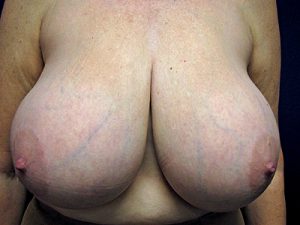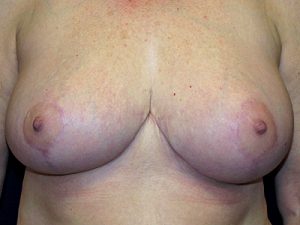Home|Blog | 5 Questions About Breast Reduction
5 Questions About Breast Reduction
Breast reduction is a plastic surgery procedure involving the removal of excess breast tissue and skin, recontouring of the breast, and repositioning it on the chest wall. It is an excellent option for those women dealing with the physical and emotional side effects associated with large breasts.
Regardless of whether large breasts developed during adolescence or were the result of pregnancy or weight gain, it is quite clear to most women that markedly enlarged breasts contribute to skin irritation, back, chest, and neck pain, bra strap indentations in the shoulder, and unwanted attention in social and professional situations. Breast reduction surgery provides tremendously rewarding results for virtually all those who have had the procedure. Typically, it ranks at the top of all plastic surgery procedures in terms of satisfaction. For many, it is life changing.
During your consultation, you will have the opportunity to ask any questions that you may have about the procedure and recovery process. Below are some of the most common questions that patients have about breast reduction surgery.


1. What Incision Option Is Best for Me?
Breast reduction removes excess glandular tissue, fat, and skin and recontours the remaining tissue to provide an aesthetically pleasing shape and the targeted size. To accomplish this, Dr. Turkeltaub employs an inverted-T shaped incision. This is generally the best option, as it allows for the desired amount of tissue removal while providing the greatest flexibility, control, and precision in order to help obtain the most desirable shape. The incisions extend around the perimeter of the areola, then down to the bottom of the breast and along the breast crease. The appearance can be equated with the shape of an anchor, which is why this approach is also known as the “anchor” incision.
There are alternative incision options for breast reduction that may result in overall shorter incision lengths, but these approaches usually have significant flaws or limitations that can lead to issues such as prominent scars, bizarre breast shapes, nipple-areolar malpositions, and unacceptable asymmetries.
2. Can I Pick My Cup Size?
Breast size is more than just a particular cup size. Even though patients may have an idea of what cup size they ultimately want to be, this may or may not be a reality, as there is no one cup size standard. All bras are cut differently; they fit differently, and cup size has just as much to do with your body shape as it does your breast size. One company’s “C” cup may fit identically to another company’s “D” cup. Therefore, it is impossible to one-hundred-percent guarantee a particular cup size.
By sharing your goals and being fairly descriptive about exactly what you are looking for, Dr. Turkeltaub can formulate a precise surgical plan that can help you realize the results you’ve dreamed of.
3. Can I Breastfeed?
Most women who undergo breast reduction should still maintain at least some ability to breastfeed, provided that a “free nipple graft” technique is not employed (where the nipple-areola complex is completely detached from the breast during surgery). As long as the nipple-areola complex is still attached and is “simply” repositioned to a more appropriate location on the breast, the connection between the milk ducts and the nipples is not severed. Of course, there will be less milk-producing tissue available due to the removal of breast tissue as part of the process.
4. Will I Lose Feeling in My Breasts?
Most women with very large breasts or who have previously breastfed already have reduced feeling in their nipples, so the risk of losing sensation following a breast reduction is generally not a major issue. I find that the vast majority of women will retain at least much of their preoperative sensation following this procedure. It is fairly rare for them to completely lose sensation in both breasts long term. With the “free nipple graft” technique, where the nipple is completely detached from the breast, loss of sensation is a given.
5. How Long Will My Recovery Take?
The recovery for breast reduction is often not nearly as long as many women fear, and the discomfort experienced is generally fairly mild. A postoperative compression dressing will be in place for two to three days. This is then replaced with a supportive bra that should be worn day and night for at least two weeks. Most patients can return to work or school after about four to seven days as long as strenuous or arm-intensive activities are not required. Aerobic activities can be resumed by about four weeks, with limitations of some for a total of eight weeks.
If you have more questions about breast reduction surgery, contact Dr. Turkeltaub at the Arizona Center for Breast Surgery by calling (480) 451-3000 or by filling out our online contact form.
